Submissions: 2022 October
-
Michael Tz
- Asternaut
- Posts: 9
- Joined: Mon Jan 31, 2022 5:19 pm
October 12 Space station Hi resolution
This is my image of the ISS taken from the university of tel Aviv in Israel.
It was a challenge to track, it was going speeding at high alt...
I used a 24" scope for this one.
It was a challenge to track, it was going speeding at high alt...
I used a 24" scope for this one.
-
Mohamedusama19
- Ensign
- Posts: 10
- Joined: Fri Aug 20, 2021 11:51 am
Re: Submissions: 2022 October
The Elephant trunk from the land of pharaohs
Copyright: Mohamed Usama Ismail / Ursamo Astrophotography
Equipment:
Imaging Lens ,Canon 135mm f2.0 L
Imaging Camera ,Canon 80D (Stock)
Mount ,Sky-Watcher Star Adventurer
Location: Egypt - Saint Catherine - Dar Eid
Date: Sept. 1, 2022
Astrobin: https://www.astrobin.com/22rp69/B/
-----------------------------------------------------------------
Facebook: https://www.facebook.com/UrsamoAstro/
Instagram: https://www.instagram.com/ursamo_astrophotography/
Copyright: Mohamed Usama Ismail / Ursamo Astrophotography
Equipment:
Imaging Lens ,Canon 135mm f2.0 L
Imaging Camera ,Canon 80D (Stock)
Mount ,Sky-Watcher Star Adventurer
Location: Egypt - Saint Catherine - Dar Eid
Date: Sept. 1, 2022
Astrobin: https://www.astrobin.com/22rp69/B/
-----------------------------------------------------------------
Facebook: https://www.facebook.com/UrsamoAstro/
Instagram: https://www.instagram.com/ursamo_astrophotography/
-
midnightlightning
- Asternaut
- Posts: 3
- Joined: Tue Oct 11, 2022 9:23 am
Re: Submissions: 2022 October
Hi All,
This is my latest image of IC1396 - The Elephant's Trunk Nebula.
Data captured from my drive in Tockwith, England over four sessions in August and September 2022 as follows:
CFF135 Refractor
QHY600 Camera
Chroma 3nm Filters : Ha, OIII, SII
Processed in PixInsight
Ha 20 x 600s
OIII 23 x 600s
SII 22 x 600s
This image is a crop taken form a larger FOV - the full image can be found at www.jonastro.co.uk
This is my latest image of IC1396 - The Elephant's Trunk Nebula.
Data captured from my drive in Tockwith, England over four sessions in August and September 2022 as follows:
CFF135 Refractor
QHY600 Camera
Chroma 3nm Filters : Ha, OIII, SII
Processed in PixInsight
Ha 20 x 600s
OIII 23 x 600s
SII 22 x 600s
This image is a crop taken form a larger FOV - the full image can be found at www.jonastro.co.uk
Re: Submissions: 2022 October
Milky Way above sea of clouds and airglow
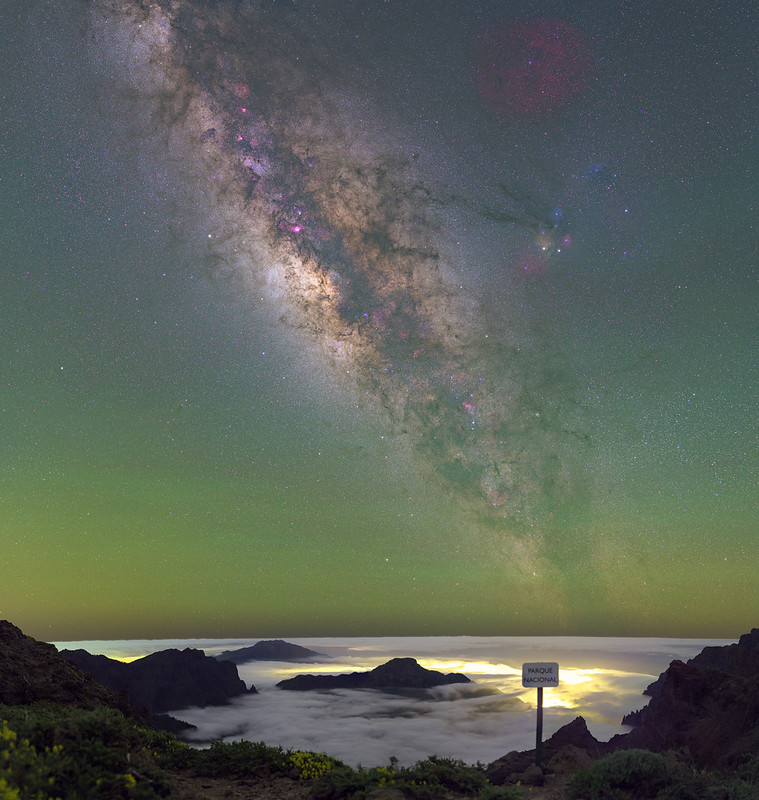
Milky Way above sea of clouds and airglow by Martin Giraud
Social : https://www.instagram.com/tinmar_g/
Here is a panorama photography of the Milky Way that I did during my recent trip in La Palma. You can see the Milky Way core above a see of clouds that block the light pollution from the cities below. You can also see at the horizon airglow (green glows emitted by our atmosphere) which is a sign of a clear sky.
La Palma island in Canary is a very well known location by the astrophotographers. Indeed the sky conditions are outstanding enough that it’s considered as one of the best spot of the north hemisphere for astronomy. It’s a Volcanic island that hosts several international telescopes regrouped into a park called Roque de los Muchachos that is located on the top of the caldeira at 2400m.
I took this picture the first night of my trip. For this first session my plan was to start gently, I had identified an easy spot where to park the car and shoot next to it but unfortunately this spot was already occupied… so I had to park the car somewhere else and to climb on the mountain through a little path that I found in the night until to have a clear view to the Milky Way. The car was too far to join it for a rest so I spend the most night out, it was my first night totally solo without lost in the nature. That was an experiment !
The picture is a panorama of 12 tiles (3 rows of 4 tiles) for the sky and a raw of 4 tiles for the background. Each tile is several, 6 for the sky and 4 for the foreground photography stacked. For each pic I used those setting : ISO-2500 - F2.2 - 30 sec
Equipment : Canon 6D - Sigma ART 50mm - Star Adventurer

Milky Way above sea of clouds and airglow by Martin Giraud
Social : https://www.instagram.com/tinmar_g/
Here is a panorama photography of the Milky Way that I did during my recent trip in La Palma. You can see the Milky Way core above a see of clouds that block the light pollution from the cities below. You can also see at the horizon airglow (green glows emitted by our atmosphere) which is a sign of a clear sky.
La Palma island in Canary is a very well known location by the astrophotographers. Indeed the sky conditions are outstanding enough that it’s considered as one of the best spot of the north hemisphere for astronomy. It’s a Volcanic island that hosts several international telescopes regrouped into a park called Roque de los Muchachos that is located on the top of the caldeira at 2400m.
I took this picture the first night of my trip. For this first session my plan was to start gently, I had identified an easy spot where to park the car and shoot next to it but unfortunately this spot was already occupied… so I had to park the car somewhere else and to climb on the mountain through a little path that I found in the night until to have a clear view to the Milky Way. The car was too far to join it for a rest so I spend the most night out, it was my first night totally solo without lost in the nature. That was an experiment !
The picture is a panorama of 12 tiles (3 rows of 4 tiles) for the sky and a raw of 4 tiles for the background. Each tile is several, 6 for the sky and 4 for the foreground photography stacked. For each pic I used those setting : ISO-2500 - F2.2 - 30 sec
Equipment : Canon 6D - Sigma ART 50mm - Star Adventurer
-
OurAstroLife
- Asternaut
- Posts: 2
- Joined: Wed Oct 12, 2022 9:46 pm
Re: Submissions: 2022 October
This is the faintest target I have ever imaged. The Squid nebula (Outters 4) is located inside the Flying Bat nebula (the red region of ionized hydrogen gas). This nebula is located 2,300 light-years away in the constellation of Cepheus. The Squid is considered to be an outflow from the star system HR8119 in the center of the Squid nebula.
I used a ZWO ASI1600MM Pro with a Celestron C11 EdgeHD in hyperstar mode. I was using a ZWO EFW and Astronomik RGBHaO3 filters. I collected 30 hours of data from my backyard over several nights to get this image. I was imaging from my Bortle 6 backyard just outside Calgary, Alberta, Canada.
https://www.facebook.com/photo/?fbid=10 ... 3631230825
Abdur Anwar
@OurAstroLife
I used a ZWO ASI1600MM Pro with a Celestron C11 EdgeHD in hyperstar mode. I was using a ZWO EFW and Astronomik RGBHaO3 filters. I collected 30 hours of data from my backyard over several nights to get this image. I was imaging from my Bortle 6 backyard just outside Calgary, Alberta, Canada.
https://www.facebook.com/photo/?fbid=10 ... 3631230825
Abdur Anwar
@OurAstroLife
-
martinkonrat
- Ensign
- Posts: 39
- Joined: Sun Sep 11, 2022 12:53 pm
Re: Submissions: 2022 October

The Witch Watches her Crystal Ball. IC 2118, Rigel and a lot of tiny galaxies. OSC.
Witch Head Nebula – IC 2118, In Eridanus
The Witch Head Nebula (located around 1,000 light years away from Earth) is categorized as a reflection nebula, or one that shines with the aid of a nearby star. In this case, Rigel shines its bright light on the gas and dust to create the reflection that we see.
The dust reflects more blue light than red, which gives it its eerie purplish-blue hue.
🗓 October, 3rd to 5th. 2022
🕶 Antlia 5nm duo narrowband filter (alp-t), IDAS LPS-P3 broadband LP filter
- 65 x 300s Duo Narrowband
- 183 x 120s Idas LPS-P3
- total integration time: ~11,5h
-
martinkonrat
- Ensign
- Posts: 39
- Joined: Sun Sep 11, 2022 12:53 pm
Re: Submissions: 2022 October

The Seven Sisters (Pleiades Star Cluster, M45) in Taurus.
I tried to be truthful to this target. This part of the sky has a wide area of little-to-none real background,
and my goal was to show the cluster with details but also not to kill the dust surrounding it.
The final image showed up as a dreamy-looking framing.
The Pleiades are an example of an open star cluster.
A group of stars that were all born around the same time from a gigantic cloud of gas and dust.
The brightest stars in the formation glow a hot blue and formed within the last 100 million years.
They are extremely luminous and will burn out quickly, with life spans of only a few hundred million years,
much shorter than the billions of years our sun will enjoy.
🗓 September, 24st to October, 2nd. 2022
🕶 Antlia L,R,G,B filters
- 201 x 120s Luminance frames (6,7h)
- 35 x 120s Red frames (1,16h)
- 42 x 120s Green frames (1,4h)
- 51 x 120s Blue frames (1,7h)
- total integration time: ~11h
-
martinkonrat
- Ensign
- Posts: 39
- Joined: Sun Sep 11, 2022 12:53 pm
Re: Submissions: 2022 October

From WR-134 to The Tulip Nebula in Cygnus (SHO)
Very hard target for us in the south, it only rises about 24 degrees height where I live (-28).
🗓 September, 23rd to 25th. 2022
🕶 Antlia Ha, Oiii and Sii 3nm filters
- 83 x 180s Ha frames
- 69 x 180s Sii frames
- 72 x 180s Oiii frames
- total integration time: ~11h
-
Guest
Re: Submissions: 2022 October
BBCode: https://flic.kr/p/2nSyLw6
Instagram: https://www.instagram.com/fstopstills/
Title: Se7en
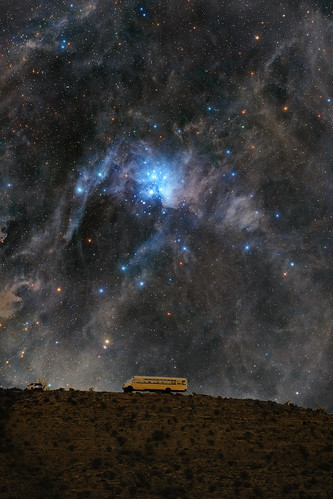 Pleaides_Terlingua by Mohib Khan, on Flickr
Pleaides_Terlingua by Mohib Khan, on Flickr
M45 aka Pleiades aka Seven sisters is an open star cluster which glow a hot blue and were formed within the last 100 million years. They are easier to spot even from the cities, rising in NE portion of winter sky in the Northern hemisphere.
In Greek mythology these are the called the seven sisters, daughters of the titan Atlas who became an object of pursuit after a chance meeting with Orion. To save them from relentless Orion, Zeus turned them into a flock of doves which he then sent to heavens to become stars.
In Wyoming, North America, stands Mateo Tipi – or Devil’s Tower as it is now widely known – a 1,200 ft tall rock formation. According to legends of Kiowa tribe, seven young girls were chased by monstrous bears. To save themselves, the frightened girls leapt on a small rock and asked the great spirit to help them. The spirit heard the girls cries and made the rock grow upwards. The bears continued to claw at the rock leaving deep scratch marks and making it grow even taller, pushing the seven girls into the stars.
There was a slight breeze with some gusts in between when I started to photograph the cluster but I kept on going and didn’t check how the shots were coming out. After 40 or so shots, I finally decided to see how they were and to my despair all of them had trailing. So I moved my setup in a sheltered area (hence the composite), polar aligned again and reduced the exposure to 60 seconds to get acceptably sharp photos. This is my favorite area of the night sky during the winter months (more than Orion) and I have tried to photograph this before but never to my satisfaction so as to post it. Either due to lack of post processing skills or the light polluted area I photographed this from, I was never able to extract details like I did in this one. I specifically bought my Rokinon 135 mm to photograph this area and I am very happy with the results. So happy that I consider this as my favorite shot of all time.
Exif:
Tracker: @skywatcherusa star adventurer
Camera : @nikonusa Z6Ii
Lens: @rokinon 135mm
Tripod: @reallyrightstuff TVC 24L
FG: [f/2.8 || 135mm || ISO 2500 || 120 sec] x 1
Sky: [f/3.2 || 135mm || ISO 2500 || 60 sec] x 110 (Almost 2 hours integration)
Post processed in Lightroom, Pixinsight and Photoshop.
Instagram: https://www.instagram.com/fstopstills/
Title: Se7en
 Pleaides_Terlingua by Mohib Khan, on Flickr
Pleaides_Terlingua by Mohib Khan, on FlickrM45 aka Pleiades aka Seven sisters is an open star cluster which glow a hot blue and were formed within the last 100 million years. They are easier to spot even from the cities, rising in NE portion of winter sky in the Northern hemisphere.
In Greek mythology these are the called the seven sisters, daughters of the titan Atlas who became an object of pursuit after a chance meeting with Orion. To save them from relentless Orion, Zeus turned them into a flock of doves which he then sent to heavens to become stars.
In Wyoming, North America, stands Mateo Tipi – or Devil’s Tower as it is now widely known – a 1,200 ft tall rock formation. According to legends of Kiowa tribe, seven young girls were chased by monstrous bears. To save themselves, the frightened girls leapt on a small rock and asked the great spirit to help them. The spirit heard the girls cries and made the rock grow upwards. The bears continued to claw at the rock leaving deep scratch marks and making it grow even taller, pushing the seven girls into the stars.
There was a slight breeze with some gusts in between when I started to photograph the cluster but I kept on going and didn’t check how the shots were coming out. After 40 or so shots, I finally decided to see how they were and to my despair all of them had trailing. So I moved my setup in a sheltered area (hence the composite), polar aligned again and reduced the exposure to 60 seconds to get acceptably sharp photos. This is my favorite area of the night sky during the winter months (more than Orion) and I have tried to photograph this before but never to my satisfaction so as to post it. Either due to lack of post processing skills or the light polluted area I photographed this from, I was never able to extract details like I did in this one. I specifically bought my Rokinon 135 mm to photograph this area and I am very happy with the results. So happy that I consider this as my favorite shot of all time.
Exif:
Tracker: @skywatcherusa star adventurer
Camera : @nikonusa Z6Ii
Lens: @rokinon 135mm
Tripod: @reallyrightstuff TVC 24L
FG: [f/2.8 || 135mm || ISO 2500 || 120 sec] x 1
Sky: [f/3.2 || 135mm || ISO 2500 || 60 sec] x 110 (Almost 2 hours integration)
Post processed in Lightroom, Pixinsight and Photoshop.
Iris Nebula
NGC7023 - 126 shots at 300 seconds each in a 3 panel mosaic. Shot from my backyard with a ZWO ASI2600MC camera, William Optics GT81 telescope, and Losmandy GM811G equatorial mount taken on October 2nd, 2022.
-
astrohokie
- Ensign
- Posts: 36
- Joined: Thu Oct 14, 2021 10:32 pm
Re: Submissions: 2022 October
Grand Teton Mormon Row Milky Way
https://www.instagram.com/mark_hoffman_photography/
Instagram: @Mark_Hoffman_Photography
Copyright: Mark Hoffman
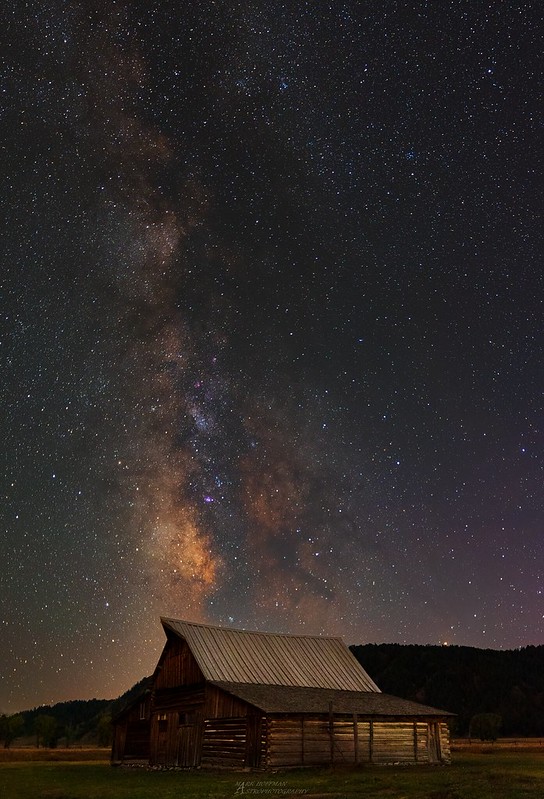 Mormon Row Barn sRGB by mark h, on Flickr
Mormon Row Barn sRGB by mark h, on Flickr
Sept 27, 2022 Grand Teton National Park
Moon: Waxing Crescent 4%
Nikon D5600 unmodified
f/2.8 17mm ISO 1600 90 sec sky
f/2.8 17mm ISO 1600 150 sec foreground
Blended in photoshop with curves/exposure/brightness/hue/saturation
https://www.instagram.com/mark_hoffman_photography/
Instagram: @Mark_Hoffman_Photography
Copyright: Mark Hoffman
 Mormon Row Barn sRGB by mark h, on Flickr
Mormon Row Barn sRGB by mark h, on FlickrSept 27, 2022 Grand Teton National Park
Moon: Waxing Crescent 4%
Nikon D5600 unmodified
f/2.8 17mm ISO 1600 90 sec sky
f/2.8 17mm ISO 1600 150 sec foreground
Blended in photoshop with curves/exposure/brightness/hue/saturation
Re: Submissions: 2022 October
The Cocoon nebula HA+RGB.
RGB data about 8 hours with Takahashi Epsilon 180 and ZWO ASI2400 MC Pro camera.
H-alpha data about 16 hours with Takahashi FSQ106 and ZWO ASI 6200 MM PRO camera + Chroma 3nm filter.
Instagram https://www.instagram.com/andyermolli/
RGB data about 8 hours with Takahashi Epsilon 180 and ZWO ASI2400 MC Pro camera.
H-alpha data about 16 hours with Takahashi FSQ106 and ZWO ASI 6200 MM PRO camera + Chroma 3nm filter.
Instagram https://www.instagram.com/andyermolli/
Re: Submissions: 2022 October
M101 in H-alpha and continuum light
M101 (also known as Pinwheel Galaxy) is a large spiral galaxy in constellation Ursa Major. It contains many bright HII regions. Some of them even have their own NGC numbers.
The image was calculated with and without H-alpha information. By toggling between the two variants the correlation between HII gas clouds and bluish regions (containing young stars and probably also OIII gas) can be visualized.
Click on the animation for detailed information and full resolution pictures.
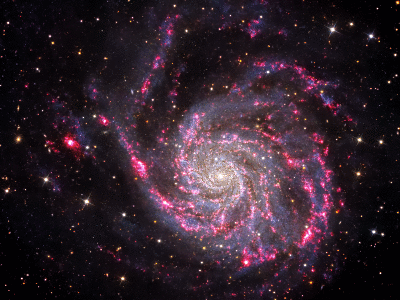
---
My Homepage
RSS news feed
M101 (also known as Pinwheel Galaxy) is a large spiral galaxy in constellation Ursa Major. It contains many bright HII regions. Some of them even have their own NGC numbers.
The image was calculated with and without H-alpha information. By toggling between the two variants the correlation between HII gas clouds and bluish regions (containing young stars and probably also OIII gas) can be visualized.
Click on the animation for detailed information and full resolution pictures.

---
My Homepage
RSS news feed
Re: Submissions: 2022 October
Dear Apod Team i reedit my latest images from iceland for a better perfection details, thank you for your support and sharing the knowledge with the world
 Orion & Aurora
Orion & Aurora
Orion is Rising Over The North Pole in Iceland
Date : Oct 5
Location : Iceland
Copyrights - Roi Levi
Website - https://www.instagram.com/astroi_levi/
Educational Data RGB frame, H alpha Frame, RGB+ha alpha, Panorama
Gear - Rgb+Ha Canon EOS RA+ Sigma Art 14 mm F1.8
Story - when the winter comes orion constellation is back to the northern night skies along with Rosette nebula , horsehead nebula ,Barnard's Loop nebula, California Nebula, and the Pleiades Star Cluster,
i had a dream, my vision was to capture orion with aurora , its a hard mission but i vision it in my head and i knew it is possible to get and h alpha stack and rgb with out moving the tripod and blend it .
on my latest trip into iceland with the talented Benjamin Barakat i was waiting to orion to rise over the magical northern lights in bortle 2 skies near Vesterhorn in iceland i was saying Hello to orion from the North pole. dream came true! Hello Orion Welcome Back To the Northern Hemisphere!
Orion is Rising Over The North Pole in Iceland
Date : Oct 5
Location : Iceland
Copyrights - Roi Levi
Website - https://www.instagram.com/astroi_levi/
Educational Data RGB frame, H alpha Frame, RGB+ha alpha, Panorama
Gear - Rgb+Ha Canon EOS RA+ Sigma Art 14 mm F1.8
Story - when the winter comes orion constellation is back to the northern night skies along with Rosette nebula , horsehead nebula ,Barnard's Loop nebula, California Nebula, and the Pleiades Star Cluster,
i had a dream, my vision was to capture orion with aurora , its a hard mission but i vision it in my head and i knew it is possible to get and h alpha stack and rgb with out moving the tripod and blend it .
on my latest trip into iceland with the talented Benjamin Barakat i was waiting to orion to rise over the magical northern lights in bortle 2 skies near Vesterhorn in iceland i was saying Hello to orion from the North pole. dream came true! Hello Orion Welcome Back To the Northern Hemisphere!
-
Efrain Morales
- Commander
- Posts: 508
- Joined: Fri Oct 22, 2010 8:15 pm
- AKA: Jaicoa
- Location: Aguadilla, Puerto Rico
- Contact:
Jupiter - October 13th
Jupiter and the GRS now gradually gaining distance as time progresses from its closest approach to Earth since October 1963. (LX200ACF 305mm OTA, CGE mount, ASI290mm Cmos, PowerMate 2.5x barlows, Astronomik RGB filter set.)
-
Robservatory
- Ensign
- Posts: 28
- Joined: Thu Jul 28, 2022 3:26 pm
Re: Submissions: 2022 October
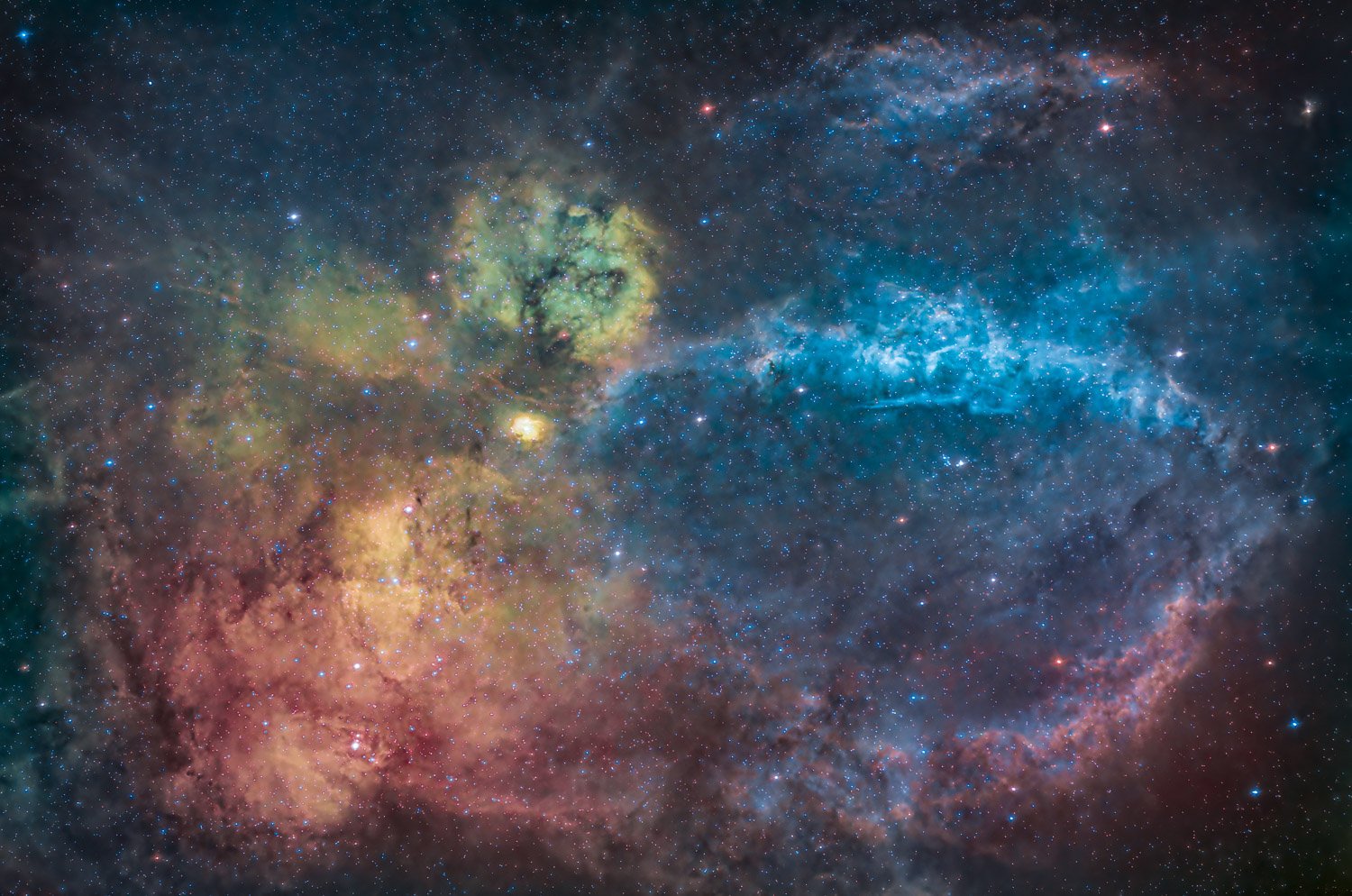
The Lobster Claw Nebula in the constellation Cassiopeia. Imaged from Vancouver, Canada over 3 nights in October, 2022.
Telescope: Sky-Watcher Quattro 150P
Mount: ZWO AM5
Camera: ZWO ASI183MM Pro
Filters: Antlia 3nm Pro
Total Integration: 24.6 hours
Re: Submissions: 2022 October
NGC 281
About 5 Horus of Luminance data and 18 minutes each of RGB with the Celestron RASA 8 and ZWO ASI 1600 MM pro
https://www.instagram.com/andyermolli/
About 5 Horus of Luminance data and 18 minutes each of RGB with the Celestron RASA 8 and ZWO ASI 1600 MM pro
https://www.instagram.com/andyermolli/
-
miguel.ventura83
- Asternaut
- Posts: 1
- Joined: Fri Oct 14, 2022 8:27 pm
Re: Submissions: 2022 October
Last edited by bystander on Sat Oct 15, 2022 3:42 pm, edited 1 time in total.
Reason: All <img> tags require image urls not page urls. Uploaded as attachment.
Reason: All <img> tags require image urls not page urls. Uploaded as attachment.
-
oldfrankland
- Asternaut
- Posts: 1
- Joined: Sat Oct 15, 2022 4:59 pm
Re: Submissions: 2022 October
https://www.flickr.com/photos/8091438@N04/52429971608/
Fascinated with the work of Dr. Thomas Berger, Lockheed Solar and Astrophysics Lab, and associates, specifically their studies of solar prominence 'bubble voids' and 'rising plumes' with the Hinode/SOT space telescope, I was excited to discover I could observe some of these events first hand with a backyard solar telescope. This particularly dramatic bubble void and rising plume sequence was shot on 08 Oct. 2022 between 17:42 and 18:05 UT with a 4 inch telescope fitted with a Daystar 0.8A H-alpha filter and a ZWO ASI174MM CMOS video camera.
Jim Ferreira
Livermore CA USA
Fascinated with the work of Dr. Thomas Berger, Lockheed Solar and Astrophysics Lab, and associates, specifically their studies of solar prominence 'bubble voids' and 'rising plumes' with the Hinode/SOT space telescope, I was excited to discover I could observe some of these events first hand with a backyard solar telescope. This particularly dramatic bubble void and rising plume sequence was shot on 08 Oct. 2022 between 17:42 and 18:05 UT with a 4 inch telescope fitted with a Daystar 0.8A H-alpha filter and a ZWO ASI174MM CMOS video camera.
Jim Ferreira
Livermore CA USA
Last edited by bystander on Sat Oct 15, 2022 8:05 pm, edited 1 time in total.
Reason: all <img> tags require image urls not page urls
Reason: all <img> tags require image urls not page urls
-
barretosmed
- Science Officer
- Posts: 482
- Joined: Thu Oct 12, 2017 6:04 pm
Re: Submissions: 2022 October
THE DOUBLE STAR AL NIYAT (Sigma Scorpii) AND SHARPLESS 9
BEST DETAILS:
https://www.astrobin.com/full/qc38ma/B/
EQUIPMENT:
Espirit 150mm triplet
Zwo asi 6200mc
Mount CEM120
145x300"
50x100"
LOCATION: Munhoz - MG - Brazil
DATES: 07/03/2022 to 08/20/2022
Author: Fernando Oliveira de Menezes
(Organizing author of the book Amateur Astrophotography in Brazil)
https://clubedeautores.com.br/livro/ast ... -no-brasil
Copyright: Your name
BEST DETAILS:
https://www.astrobin.com/full/qc38ma/B/
EQUIPMENT:
Espirit 150mm triplet
Zwo asi 6200mc
Mount CEM120
145x300"
50x100"
LOCATION: Munhoz - MG - Brazil
DATES: 07/03/2022 to 08/20/2022
Author: Fernando Oliveira de Menezes
(Organizing author of the book Amateur Astrophotography in Brazil)
https://clubedeautores.com.br/livro/ast ... -no-brasil
Copyright: Your name
Re: Submissions: 2022 October
NGC-6543 The Cat's Eye Nebula (HOO+LRGB)
About 3,000 light years from Earth, is the central star of NGC-6543, a Wolf-Rayet O7 class star. The core of NGC-6543 consists of an inner bubble that is nested inside of a pair of larger bubbles
Target: NGC-6543
Imaging Telescope: Explore Scientific ED127 CF
Imaging Camera: ZWO ASI2600MM-Pro
Guide Scope: Explore Scientific ED127 CF
Guide Camera: ZWO 290mm-Mini
Mount: Sky Watcher EQ8-R Pro
Polar Alignment: ASIAir Plus
Bortle Class: 6
Filter: Chroma 3nm
100 x 180s (Ha)
75 x 300s (Ha)
100 x 300s (OIII)
100 x 30s (L)
100 x 30s (R)
100 x 30s (G)
100 x 30s (B)
Integration: PixInsight
9-11 Oct 2022
AstroBin Full Resolution: https://astrob.in/l7m9u6/D/
About 3,000 light years from Earth, is the central star of NGC-6543, a Wolf-Rayet O7 class star. The core of NGC-6543 consists of an inner bubble that is nested inside of a pair of larger bubbles
Target: NGC-6543
Imaging Telescope: Explore Scientific ED127 CF
Imaging Camera: ZWO ASI2600MM-Pro
Guide Scope: Explore Scientific ED127 CF
Guide Camera: ZWO 290mm-Mini
Mount: Sky Watcher EQ8-R Pro
Polar Alignment: ASIAir Plus
Bortle Class: 6
Filter: Chroma 3nm
100 x 180s (Ha)
75 x 300s (Ha)
100 x 300s (OIII)
100 x 30s (L)
100 x 30s (R)
100 x 30s (G)
100 x 30s (B)
Integration: PixInsight
9-11 Oct 2022
AstroBin Full Resolution: https://astrob.in/l7m9u6/D/
-
barretosmed
- Science Officer
- Posts: 482
- Joined: Thu Oct 12, 2017 6:04 pm
Re: Submissions: 2022 October
PIPE NEBULA
Dark nebulae are a show apart. In the central region of the Milky Way, it features the Pipe Nebula, made up of the dark nebulae B59, B72, B77 and B78.
The Pipe Nebula is part of the Ophiuchus dark cloud complex about 450 light-years away from Earth.
Equipment:
Canon 200mm Lens
Canon 6d
21x 100 sec
Smart-eq ioptron mount, unguided
Processing and capture:
Software: Pixinsight, Adobe Photoshop, APT,, Polemaster, SharpCap
LOCATION: Munhoz - MG - Brazil
Copyright: Fernando Oliveira de Menezes
(Organizing author of the book Amateur Astrophotography in Brazil)
https://clubedeautores.com.br/livro/ast ... -no-brasil
Dark nebulae are a show apart. In the central region of the Milky Way, it features the Pipe Nebula, made up of the dark nebulae B59, B72, B77 and B78.
The Pipe Nebula is part of the Ophiuchus dark cloud complex about 450 light-years away from Earth.
Equipment:
Canon 200mm Lens
Canon 6d
21x 100 sec
Smart-eq ioptron mount, unguided
Processing and capture:
Software: Pixinsight, Adobe Photoshop, APT,, Polemaster, SharpCap
LOCATION: Munhoz - MG - Brazil
Copyright: Fernando Oliveira de Menezes
(Organizing author of the book Amateur Astrophotography in Brazil)
https://clubedeautores.com.br/livro/ast ... -no-brasil
Re: Submissions: 2022 October
Barnard 344, a dark nebula located in the constellation Cygnus, stretches 50 light-years across and is about 1800 light-years away. Captured over 7 nights, equaling 29.5 hours of exposure, from my backyard observatory. Nebulae processed in the Hubble palette with 3nm narrowband filters, with RGB data used for the stars.
Telescope: Sky-Watcher Quattro 250P
Imaging Camera: ZWO ASI294MM Pro
Mount: Astro-Physics Mach2 GTO ×
Filters: Chroma Blue 31 mm · Chroma Green 31 mm · Chroma H-alpha 3nm Bandpass 31 mm · Chroma OIII 3nm Bandpass 31 mm · Chroma Red 31 mm · Chroma SII 3nm Bandpass 31 mm
Accessories: Tele Vue 2" Paracorr Type-2 (VIP-2010)
Software: Open PHD Guiding Project PHD2 · Pleiades Astrophoto PixInsight · Starkeeper.IT Voyager
Acquisition details
Dates:
July 28, 2022 · July 29, 2022 · Aug. 1, 2022 · Aug. 4, 2022 · Aug. 5, 2022 · Aug. 8, 2022 · Aug. 9, 2022
Frames:
Chroma Blue 31 mm: 30×180″(1h 30′) bin 2×2
Chroma Green 31 mm: 30×180″(1h 30′) bin 2×2
Chroma H-alpha 3nm Bandpass 31 mm: 105×300″(8h 45′) bin 2×2
Chroma OIII 3nm Bandpass 31 mm: 98×300″(8h 10′) bin 2×2
Chroma Red 31 mm: 30×180″(1h 30′) bin 2×2
Chroma SII 3nm Bandpass 31 mm: 92×300″(7h 40′) bin 2×2
Integration: 29h 5′
Telescope: Sky-Watcher Quattro 250P
Imaging Camera: ZWO ASI294MM Pro
Mount: Astro-Physics Mach2 GTO ×
Filters: Chroma Blue 31 mm · Chroma Green 31 mm · Chroma H-alpha 3nm Bandpass 31 mm · Chroma OIII 3nm Bandpass 31 mm · Chroma Red 31 mm · Chroma SII 3nm Bandpass 31 mm
Accessories: Tele Vue 2" Paracorr Type-2 (VIP-2010)
Software: Open PHD Guiding Project PHD2 · Pleiades Astrophoto PixInsight · Starkeeper.IT Voyager
Acquisition details
Dates:
July 28, 2022 · July 29, 2022 · Aug. 1, 2022 · Aug. 4, 2022 · Aug. 5, 2022 · Aug. 8, 2022 · Aug. 9, 2022
Frames:
Chroma Blue 31 mm: 30×180″(1h 30′) bin 2×2
Chroma Green 31 mm: 30×180″(1h 30′) bin 2×2
Chroma H-alpha 3nm Bandpass 31 mm: 105×300″(8h 45′) bin 2×2
Chroma OIII 3nm Bandpass 31 mm: 98×300″(8h 10′) bin 2×2
Chroma Red 31 mm: 30×180″(1h 30′) bin 2×2
Chroma SII 3nm Bandpass 31 mm: 92×300″(7h 40′) bin 2×2
Integration: 29h 5′
- felopaul
- Ensign
- Posts: 97
- Joined: Mon Apr 29, 2013 7:14 pm
- AKA: Felopaul
- Location: Flagey (France)
- Contact:
Re: Submissions: 2022 October
M 20
HOORVB : SHORVB : full size/info : http://www.cielaustral.com/galerie/photo137.html
81 Hrs total frames
done with CDK 610, Moravian C4-16000 on PW L600 mount near Actacama Desert in Chile, El Sauce Observatory
http://www.cielaustral.com
Copyright: Team CielAustral with J.C CANONNE, M. SELBY, G.CHASSAIGNE, N.OUTTERS, P. BERNHARD, D. CHAPLAIN & L. BOURGON
HOORVB : SHORVB : full size/info : http://www.cielaustral.com/galerie/photo137.html
81 Hrs total frames
done with CDK 610, Moravian C4-16000 on PW L600 mount near Actacama Desert in Chile, El Sauce Observatory
http://www.cielaustral.com
Copyright: Team CielAustral with J.C CANONNE, M. SELBY, G.CHASSAIGNE, N.OUTTERS, P. BERNHARD, D. CHAPLAIN & L. BOURGON
- felopaul
- Ensign
- Posts: 97
- Joined: Mon Apr 29, 2013 7:14 pm
- AKA: Felopaul
- Location: Flagey (France)
- Contact:
Re: Submissions: 2022 October
NGC 3586
SHORVB : HOORVB : full size/info : http://www.cielaustral.com/galerie/photo138.html
81 Hrs total frames
done with CDK 610, Moravian C4-16000 on PW L600 mount near Actacama Desert in Chile, El Sauce Observatory
http://www.cielaustral.com
Copyright: Team CielAustral with J.C CANONNE, M. SELBY, G.CHASSAIGNE, N.OUTTERS, P. BERNHARD, D. CHAPLAIN & L. BOURGON
SHORVB : HOORVB : full size/info : http://www.cielaustral.com/galerie/photo138.html
81 Hrs total frames
done with CDK 610, Moravian C4-16000 on PW L600 mount near Actacama Desert in Chile, El Sauce Observatory
http://www.cielaustral.com
Copyright: Team CielAustral with J.C CANONNE, M. SELBY, G.CHASSAIGNE, N.OUTTERS, P. BERNHARD, D. CHAPLAIN & L. BOURGON

